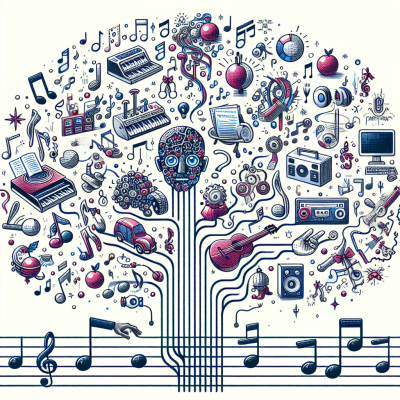
The Rise of AI-Generated Slop Music
AI-generated content has taken the virtual world by storm, and music is no exception. From poetic ballads to experimental soundscapes, the creative capabilities of artificial intelligence were once a marvel. However, in 2024, listeners are finding themselves confronted with a new, wilder flavor of machine-made art: AI slop music. Tracks with titles like “Taste My Ass” and “I Caught Santa Claus Sniffing Cocaine” are cropping up across major streaming platforms—Spotify, Apple Music, YouTube, and more—often without users intentionally searching for them.
But how did we get here? And why is AI-generated musical absurdity becoming impossible to ignore? Let’s explore.
What Is AI Slop Music?
Defining the Trend
The term “slop music” refers to lazily created, algorithmically generated music that often features bizarre lyrics, surreal themes, and questionable artistic merit. Unlike previous AI compositions designed to mimic human composers or famous artists, this new wave leans into chaos, randomness, and absurdity.
Key characteristics of AI slop music include:
- Low-effort production using generative AI models
- Surreal or provocative lyrics created by language models
- Titles designed to provoke curiosity or game SEO/search algorithms
- Mass upload strategies to flood platforms with content
Case in Point: “Taste My Ass”
Consider “Taste My Ass,” a track that has achieved notoriety not because of its artistic quality but because of its unapologetic weirdness. Composed entirely by AI, this tune combines a generic beat, poorly generated vocals, and a concept that seems better suited for an internet joke than a Spotify playlist.
Even Stranger: Santa and the Coke Habit
“I Caught Santa Claus Sniffing Cocaine” sounds like a holiday parody gone horribly wrong, but it’s representative of a broader trend: clickbait song titles engineered by AI to capitalize on shock value and search engine optimization.
Why Is This Music Everywhere?
Gaming the Algorithm
AI musicians—often backed by people running low-effort content farms—are exploiting how platforms index and recommend music. Algorithms favor fresh content, engagement, and keyword relevance. By pumping out thousands of tracks with unusual themes or titles that might generate curiosity clicks, these music factories are flooding the digital landscape to gain income from streams.
Spotify’s Role
Spotify and similar platforms have a recommendation system that’s increasingly driven by user habits and algorithmic predictions. But when AI-produced tracks use trending keywords or tags, they may surface even in unrelated playlists. Some users have reported hearing AI slop songs inserted into genre playlists or autoplay queues post-album playback.
Despite listener backlash, services like Spotify often benefit financially from these ultra-low-cost uploaders due to royalty divisions—even if a track is a literal joke.
Can Listeners Tell the Difference?
A Growing Concern
At a surface level, many listeners can tell that there’s something off about these songs. The voices are synthetic. The lyrics often don’t make sense. The melody is repetitive, and emotional depth is absent.
But for casual background listeners, slop music can blend in—especially in situations like workout mixes, sleep playlists, or algorithmically generated radio stations.
The Filter Fails
The sheer number of uploads and use of strategic tagging means that AI slop often slips through content moderation or platform quality controls. Millions of AI-generated tracks are being added to streaming services, creating an overwhelming digital noise floor that makes discovering genuine independent artists more difficult.
The Ethical and Cultural Implications
Art or Anti-Art?
There’s an ongoing debate about whether AI slop is a form of digital dadaism—poking fun at artistic norms—or just pointless data pollution. While it may be humorous at times, this music raises questions about:
- The devaluation of music as an art form
- Exploitation of streaming loopholes for monetary gain
- The sustainability of attention-based economy models
Impact on Human Musicians
As platforms balloon with AI noise, independent and smaller artists are finding it harder to break through the static. With Spotify’s payment model rewarding volume over quality, genuine musicians are being edged out by content that’s often auto-generated en masse.
What’s Being Done?
Platform Crackdowns and the Future of Generative Music
Some streaming platforms have started to implement AI-content detection—to identify and regulate the flood of machine-generated songs. However, given the speed and volume at which these tracks are created, enforcement is challenging.
A long-term solution would involve:
- Clearer labeling of AI-generated music
- New royalty structures for synthetic content
- Updated community guidelines for music platforms
Consumer Awareness
For now, one of the best defenses is consumer awareness. By understanding how AI slop music spreads, listeners can become more discerning and support real artists and labels instead of algorithmically optimized spam.
Final Thoughts: A Glitch in the Harmony
We may be on the edge of a new digital frontier where creativity and code intertwine—but not every output deserves a platform. AI slop music, while amusing to some, presents a bigger question: Are we letting the algorithms curate our culture?
As bizarre titles like “Taste My Ass” and “I Caught Santa Claus Sniffing Cocaine” continue to play through your smart speakers, remember that these aren’t just novelties—they’re side effects of a system in need of recalibration.
To preserve the integrity, artistry, and emotional impact of music, it may be time to stop letting the slop rise unchecked. Let the machines play their part—but on humanity’s terms.


Leave a Reply